

The Horseley Ironworks (sometimes spelled Horsley) was a major ironworks in the Tipton area in the county of Staffordshire, now the West Midlands, England.


The Horseley Ironworks (sometimes spelled Horsley) was a major ironworks in the Tipton area in the county of Staffordshire, now the West Midlands, England.
Founded by Aaron Manby, [1] it is most famous for constructing the first iron steamer, The Aaron Manby , in 1821. [2] [3] The boat was assembled at Rotherhithe. She was only the first of a number of steamboats built on the "knock-down" principle. The ironworks have also been responsible for the manufacture of numerous canal and railway bridges of the 19th century.
The ironworks were built near the Toll End Communication Canal [4] on the Horseley estate, which had been sold by their owner at the turn of the 19th century [5] due to demand from engineers wishing to profit on the construction of the BCN Main Line through the estate. The date when the ironworks were constructed is unknown but is believed to have been by 1815. [5] Industry in the area prospered and the location retained the name of the Horseley estate as shown in an 1822 survey of the area. [6]
With the increasing popularity of canals, the ironworks quickly became popular for manufacturing canal bridges, mainly in the local vicinity. [7] Canal bridges made by the ironworks include the Engine Arm Aqueduct (1825), two roving bridges at Smethwick Junction (1828), [8] [9] Galton Bridge (1829), and Braunston Towpath Bridges (1830). [10] [11] By the end of the canal construction era, Horseley Ironworks had emerged as one of the most prolific manufacturers of canal bridges in the West Midlands region, [5] especially in Birmingham. [12] This was a result of their signature bridge design which had become popular amongst canal constructors. The design has been replicated more recently, for example in Birmingham during the regeneration of Gas Street Basin where Worcester Bar is linked to Gas Street. [13]
Horseley Ironworks were also responsible for manufacturing in the railway industry. Railway bridges constructed included that of the viaduct for the London and Birmingham to Holyhead railway at Shifnal, Shropshire which was cast in 1848. [14] As well as manufacturing bridges, they also produced locomotives. [15]
The company also manufactured construction steelwork for the pier of Ryde, the Palace Theatre in London, Rugby railway station, a seaplane hangar in Las Palmas and the Dome of Discovery at the 1951 Festival of Britain. [16]
People who have worked for the iron foundry include Charles Manby, the son of Aaron Manby, James Thomson, [17] William Johnson [18] and Richard Roberts. [19]
The firm moved in 1865 to a site on the now defunct Dixon's Branch, off the BCN New Main Line (Island Line), near the South Staffordshire Railway line. The factory survived under a succession of owners until 1991, when it was closed down and subsequently redeveloped as a housing estate. [4]
| Point | Coordinates (Links to map resources) | OS Grid Ref | Notes |
|---|---|---|---|
| Horseley Ironworks (original site) | 52°32′02″N2°03′06″W / 52.5338°N 2.0517°W | SO964929 | on Toll End Communication Canal |
| Horseley Ironworks (later site) | 52°31′47″N2°02′38″W / 52.5296°N 2.0438°W | SO970924 | on Dixon's Branch |
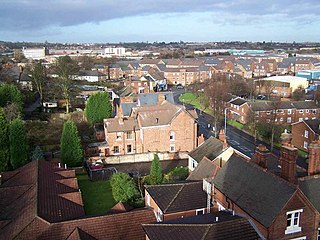
Tipton is an industrial town in the Metropolitan Borough of Sandwell in the West Midlands County in England. It had a population of 38,777 at the 2011 UK Census. It is located northwest of Birmingham and southeast of Wolverhampton. It is also contiguous with nearby towns of Darlaston, Dudley, Wednesbury and Bilston.

Smethwick is an industrial town in Sandwell, West Midlands, England. It lies 4 miles (6 km) west of Birmingham city centre. Historically it was in Staffordshire and then Worcestershire before being placed into then West Midlands County.
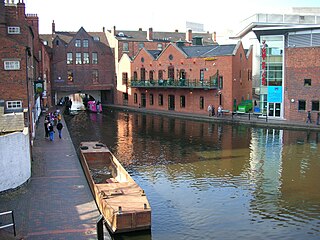
Birmingham Canal Navigations (BCN) is a network of canals connecting Birmingham, Wolverhampton, and the eastern part of the Black Country. The BCN is connected to the rest of the English canal system at several junctions. It was owned and operated by the Birmingham Canal Navigation Company from 1767 to 1948.

The Galton Bridge is a cast-iron bridge in Smethwick, near Birmingham, in the West Midlands of England. Opened in 1829 as a road bridge, the structure has been pedestrianised since the 1970s. It was built by Thomas Telford to carry a road across the new main line of the Birmingham Canal, which was built in a deep cutting. The bridge is 70 feet above the canal, making it reputedly the highest single-span arch bridge in the world when it was built, 26 feet wide, and 150 feet long. The iron components were fabricated at the nearby Horseley Ironworks and assembled atop the masonry abutments. The design includes decorative lamp-posts and X-shaped bracing in the spandrels.

The Smethwick Engine is a Watt steam engine made by Boulton and Watt, which was installed near Birmingham, England, and was brought into service in May 1779. Now at Thinktank, Birmingham Science Museum, it is the oldest working steam engine and the oldest working engine in the world.

Smethwick Galton Bridge is a split-level railway station in Smethwick, West Midlands, England. It is at a point where two railways' lines cross on two levels. It has platforms on both lines, allowing interchange between them. The two low-level platforms serve the Birmingham New Street to Wolverhampton Line, while the two high-level platforms serve the Birmingham Snow Hill to Worcester Line. The high level line passes over the low level line at a right angle on a bridge. West Midlands Railway manage the station and operate the majority of its services, with others provided by Chiltern Railways and London Northwestern Railway.

The Engine Arm or Birmingham Feeder Arm near Smethwick, West Midlands, England, is a short canal which was originally part of a feeder tunnel for a pumping engine. When the Smethwick flight of locks were reduced from six to three, the pumping engine was moved to a new site, which allowed part of the feeder tunnel to be opened up and made navigable, so that coal supplies for the engine could be delivered by barge. The Engine Arm also supplied the pumped water to the 473-foot (144 m) Wolverhampton level of the lowered summit. The arm was extended between 1825 and 1830 by Thomas Telford to carry water from Rotton Park Reservoir to the Old Main Line of the BCN Main Line Canal, and the Engine Arm Aqueduct was inserted to carry it over the new main line constructed at that time, which was 20 feet (6.1 m) lower. The arm is now managed by the Canal and River Trust and the basin beyond the site of the pumping station, which was replaced by a new engine house near Brasshouse Lane bridge in 1892, is used for residential moorings.
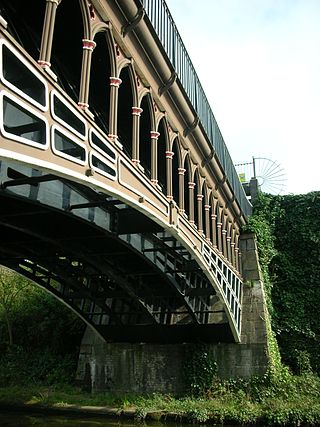
The Engine Arm Aqueduct near Smethwick, West Midlands, England, was built in 1825 by Thomas Telford to carry a water feeder, the Engine Arm, from Edgbaston Reservoir over the BCN New Main Line canal to the adjacent and parallel Old Main Line. The structure is maintained by the Canal & River Trust. It is a Scheduled Ancient Monument and is Grade II* listed.
The BCN Main Line, or Birmingham Canal Navigations Main Line is the evolving route of the Birmingham Canal between Birmingham and Wolverhampton in England.

Smethwick Junction is the name of the canal junctions where the Birmingham Canal Navigations Main Line Canal from Birmingham splits into the BCN Old Main Line and the BCN New Main Line near to Smethwick, West Midlands, England.

The Tipton Green Branch and Toll End Branch were narrow canals comprising part of the Birmingham Canal Navigations near Tipton, West Midlands, England. These canals no longer exist.

Horseley Fields Junction is a canal junction at the western limit of the Wyrley and Essington Canal where it meets the BCN Main Line, at Horseley Fields east of Wolverhampton, in the West Midlands, England.
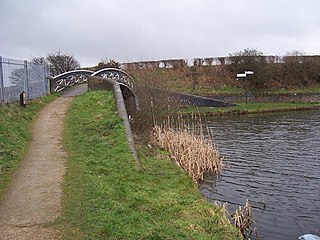
Ogley Junction, on the Staffordshire county border near Brownhills, West Midlands, England, is a historic canal junction on the Wyrley and Essington Canal where the Anglesey Branch left the main line.
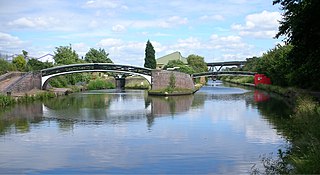
Bromford Junction is a canal junction at the foot of the Spon Lane Locks where the Spon Lane Locks Branch meets the BCN New Main Line near Oldbury in the West Midlands, England.

The Wednesbury Oak Loop, sometimes known as the Bradley Arm, is a canal in the West Midlands, England. It is part of the Birmingham Canal Navigations (BCN), and was originally part of James Brindley's main line, but became a loop when Thomas Telford's improvements of the 1830s bypassed it by the construction of the Coseley Tunnel. The south-eastern end of the loop was closed and in parts built over, following the designation of the entire loop as "abandoned" in 1954, including the section which was filled in at the beginning of the 1960s to make way for the Glebefields Estate in Tipton.
Galton Village is a residential area of Smethwick, West Midlands, England. It takes its name from the iconic nearby Galton Bridge that was named after local business man Samuel Galton whose land the new BCN Main Line canal was built through, the canal runs behind Galton Village as does the Stour Valley section of West Coast Mainline. The Oldbury Road runs through the area which begins next to Smethwick’s Galton Bridge railway station and ends at Spon Lane, next to a small shopping centre.

The Stewart Aqueduct in Smethwick, West Midlands, England carries the BCN Old Main Line Canal (1770) over the BCN New Main Line Canal (1828). Alongside and above the New Main Line Canal is the Stour Valley section of the West Coast Main Line (1852), all three being bridged by the M5 motorway.

Galton Valley Canal Museum is a small museum, located in Smethwick, England, on the border with Birmingham and alongside the BCN Main Line canals. The Museum tells the story of the development of the Galton Valley canals and those who designed, built and worked on them.

Aaron Manby was an English civil engineer and the founder of the Horseley Ironworks, notable for the many fine iron canal bridges that it built. The eponymous Aaron Manby steamboat was the first iron-hulled steamer to go to sea, and it was driven by Manby's patent Oscillating Engine, an effective and durable marine steam engine.

Charles Manby, FRS FRSA was Secretary of the Institution of Civil Engineers from November 1839 to 1856, and engineer of the first iron steamer to cross the English Channel. Fluent in French, he installed gas piping into Paris and advised on the construction of the Suez Canal.